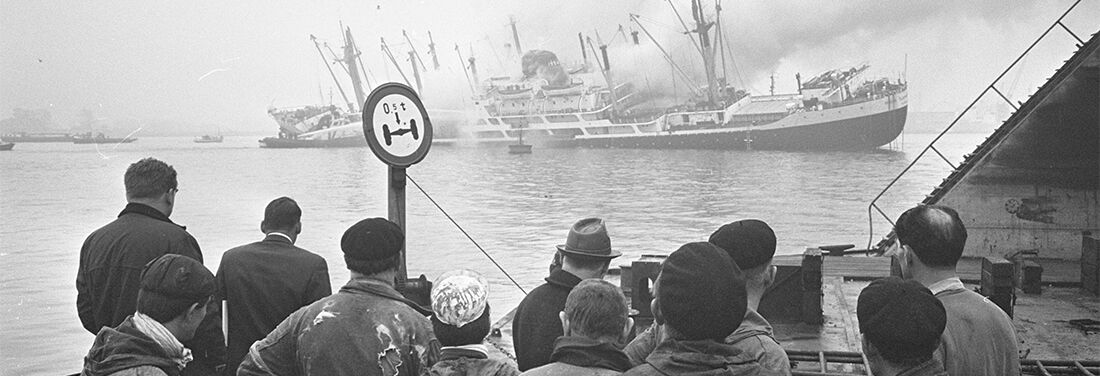Moral Seascapes. Modern Transformations of the Imagery of Shipwreck
Throughout history, the sea has been a vast repository of cultural meaning. Whether viewed as an intractable barrier or a medium of fluid mobility; a benevolent source of sustenance or a violent, merciless force of nature; whether bearing biblical, classical, or modern associations, these meanings have tended to provide insight into the human relationship with maritime space. They have also inflected the visual economy of the sea, charging representations of the maritime landscape, and of shipwreck particularly, with an excess of symbolic force.
The history of the visual tropes of seafaring and shipwreck, in the period since 1800, has commonly focused on metaphysical meanings to do with the relationship between the subject and the world, on one hand, and socio-economic meanings to do with, e.g., the transformations of capitalism, on the other. Between these two groups of meanings lies a relatively more neglected third one, that of morality. Traditionally, especially in the early modern genre of shipwreck painting, such moral meanings had held a dominant position. These meanings were always close to stating metaphysical points: the vanitas of the world, and of human works, such as states and politics, and the need for human beings to consider the end and the afterlife; and conversely the more optimistic condition of being-in-the world under the government of fortuna. This position was abandoned or just lost, over the course of modernity, or such is the general assumption.
The workshop intends to look at the moral meanings of the seascape and the shipwreck image that survived into modernity or haunted it, and those that were newly invented and added during this period. Among the latter meanings are those that relate to early humanitarian movements that concerned, for instance, the saving of lives from shipwreck or the violent transportation of slaves and convicts; and, later on, technological estrangement, moral economies of various kinds, labor conditions, the perils and plights of maritime migration, and ecological disaster. The basic hypothesis is not simply that the image type, taken at face value, can be understood through this prism of moral meanings. Rather, morality provided a specific manner of setting up image spaces that, especially in the twentieth and into the twenty-first century, came to inform many non-obvious modes of representation, into and beyond visual abstraction. This parcours of modern forms, with its move away from “realist” modes of representation, is so varied that it presumably helps to better understand the question of how, in turn, the image spaces impinged on the understanding of morality, the representation of moral spaces, and their transformations.
The workshop’s aim, then, is to bring together perspectives from visual history and the cultural history of moralities, with an agenda of mutual illumination. Concerns might include:
- What connections might we make between representations of shipwreck and the visual economy of the sea itself?
- How does the weight of historical associations borne by the sea impact engagement with imperiled seafarers in the contemporary world?
- What affective assumptions are made in cultural representations of the sea—what emotional responses do they demand of the viewer?
- How might technological innovations which mediate the limits of what is ethically possible impact our understanding of historical shifts in the sea as a moral landscape?
- Might we usefully draw parallels between the distance which underpins the aesthetic enjoyment of the maritime landscape and the distance—both physical and ethical—which allows for an attitude of moral detachment from suffering?
Fig. above: Indonesian cargo ship Tjokroaminoto on fire in the port of Amsterdam, Oct 29, 1964, photographer: Harry Pot/Anefo, © National Archieef
Program
Friday, 20 May 2022
9.00
- Intro
9.15
- Hannah Baader (Kunsthistorisches Institut, Florenz): Seascapes and Signscapes. Lepanto/Nafpaktos and Gaeta
10.30
- Hilde Van Gelder (KU Leuven): Grundsee: Claiming a right to be reborn
- Caroline Behrmann (Ruhr-Universität Bochum): Floating states: Visualities of shipwreck and communitas
14.00
- Lisa Ortner-Kreil (Kunstforum Wien): Navigation and naufragium as motif in the visual arts
- Jonathan Stafford (ZfL): The visual culture of shipwreck and the moral spectator
16.15
- Chiara Giubilaro (Università degli Studi di Palermo): Migrations, photography, and the impossible spectatorship
- Burkhardt Wolf (Universität Wien): When seascapes collide
Saturday, 21 May 2022
9.30
- Jörn Münkner (Herzog August Bibliothek, Wolfenbüttel): Aquatic freedom: Better cruising and the danger of shipwreck than languishing in the big ship on land
10.45
- Benno Wagner (Zhejiang University): Lord Karl. Jumping ship and professional ethics as narrative drivers in Conrad and Kafka
- Alexandra Heimes (ZfL): Contingency, Agency and Morality in Modern Shipwreck Situations
14.15
- Rafael Jakob (Universität Wien): Heinrich von Kleist's Weltbürgertum and the openness of the sea
- Henning Trüper (ZfL): Transfigurations of the dead of the sea
